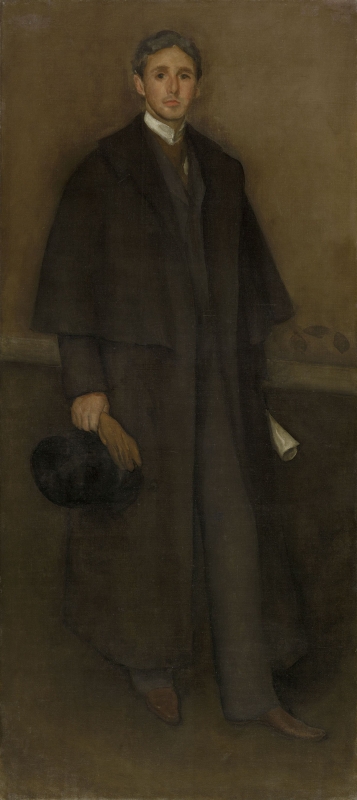Arrangement in Flesh Colour and Brown: Portrait of Arthur J. Eddy dates from 1894. 1
According to the Pennells, the portrait was commissioned by the sitter in 1893, and painted in six weeks in Whistler's Paris studio in the rue Notre-Dame-des-Champs in 1894. 2 Sittings took place in August and possibly September (an inscription in Whistler's hand on the verso is dated October 1894, when the picture was completed).
Whistler was painting and repainting the portrait until the last moment before the sitter left the country. Eddy remembered the final day:
'How well I recall the darkening studio - the last glimpse of the portrait - dim and vague in the deepening twilight, and finally the good-byes to you and Mrs. Whistler ...
What a day we had a year ago now! Every thing went (including the Canadian Club whiskey) in your grand manner -
Mrs Whistler and I did not count at all - you simply swept on regardless and I verily believe that if darkness had not intervened you would have painted the whole picture over - you really did practically.' 3
Eddy was back in Chicago by 15 September 1894, when he wrote:
'Only last night I told Mrs Eddy that you were the only man I ever met and associated with daily whom I found companionable and ever more enjoyable each succeeding day. Barring the pain and torture we had - perhaps I should say, I had - the best of times together.
But where is our portrait? I am getting anxious, lest you have painted the [Senator?] out and some other fellow in.' 4
Eddy paid 350 francs on 27 October 1894 and promised the rest when the picture arrived. 5 It was signed and dated on the verso by Whistler in October 1894. It was on its way to Chicago by 8 November 1894, and had arrived there by 5 December 1894. 6 Eddy wrote to Whistler:
I cannot tell you how glad I am to hear the picture is finished to your satisfaction - That is news I did not expect.
All the trouble of the posing was recompensed in the delightful hours spent with you - the portrait is just so much clear gain.
When it comes I shall write you what I think and what others say - I find I am already famous in many quarters as the man who bearded the lion in his den and stole a portrait - if everybody only knew how charming the lion really is - but then everybody will in January or February when you come.' 7
By 5 December the portrait had arrived and was hung, as Eddy reported to Whistler:
'I am more than pleased with it - it is a fine & graceful work of art, just such a portrait as one would expect from you. Durand-Ruel Sr. dined with me Sunday and he thought it fine.
Mrs Eddy admires it greatly as a picture but thinks it does not do me justice as a portrait - my friends hold various and conflicting views as to the likeness - It is interesting to hear the many opinions, but nothing said disturbs my conviction that it is prime - both as picture and portrait - it could not well be otherwise. If everybody liked it on first sight, I should feel it is not a Whistler. The quality of a picture is inversely [proportionate] to the number of those who propose to admire it. -
It is quite dull in places owing to the paint having sunken in - until it is varnished it will hardly look as it really is - a fine thing.' 8
Notes:
1: YMSM 1980 [more] (cat. no. 425).
2: Pennell 1908 [more] , vol. 2, p. 156.
3: [September 1895] formerly dated [20/30 October 1895], GUW #01026.
4: 15 September [1894], GUW #01015.
6: Whistler to J. Pennell, [8 November 1894], GUW #07798. Eddy to Whistler, 5 December 1894, GUW #01018.
Last updated: 27th April 2021 by Margaret






